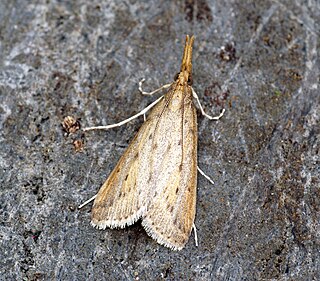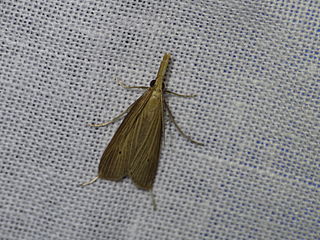
Donacaula forficella is a species of moth of the family Crambidae described by Carl Peter Thunberg in 1794. It is found in China (Heilongjiang), Europe and South Africa.

Donacaula is a genus of moths of the family Crambidae. The genus was erected by Edward Meyrick in 1890.

Schoenobiinae is a subfamily of the lepidopteran family Crambidae. The subfamily was described by Philogène Auguste Joseph Duponchel in 1846.

Parapoynx allionealis, the watermilfoil leafcutter moth, is a moth in the family Crambidae. It was described by Francis Walker in 1859. It is found in North America, where it has been recorded from Alabama, Florida, Georgia, Indiana, Louisiana, Maine, Manitoba, Maryland, Massachusetts, Michigan, Minnesota, Mississippi, New Brunswick, New Hampshire, New Jersey, New York, North Carolina, Nova Scotia, Ohio, Oklahoma, Ontario, Quebec, South Carolina, Tennessee and Texas.
Donacaula dispersella is a moth in the family Crambidae. It was described by Robinson in 1870. It is found in North America, where it has been recorded from Alberta, Manitoba, Nova Scotia, Ontario, Quebec, Saskatchewan, Arizona, Arkansas, Colorado, Connecticut, Florida, Georgia, Illinois, Kansas, Kentucky, Louisiana, Maine, Maryland, Massachusetts, Michigan, Mississippi, Nebraska, Nevada, New Hampshire, New Jersey, New York, North Carolina, Oklahoma, Pennsylvania, South Carolina, Tennessee, Texas, Utah, Vermont and Virginia.
Donacaula longirostrallus, the long-beaked donacaula moth, is a moth in the family Crambidae. It was described by James Brackenridge Clemens in 1860. It is found in North America, where it has been recorded from Nova Scotia, Ontario, Quebec, Alabama, Arkansas, Connecticut, Florida, Louisiana, Maine, Massachusetts, Michigan, Mississippi, Nebraska, New Jersey, New York, North Carolina, Pennsylvania, Texas, Vermont and Virginia.
Donacaula maximellus is a moth in the family Crambidae. It was described by Charles H. Fernald in 1891. It is found in North America, where it has been recorded from Florida, Georgia, Louisiana, Mississippi, Nebraska, North Carolina and South Carolina.

Donacaula melinella is a moth in the family Crambidae. It was described by James Brackenridge Clemens in 1860. It is found in North America, where it has been recorded from Ontario, Alabama, Arizona, Arkansas, Connecticut, Delaware, Florida, Georgia, Illinois, Indiana, Kentucky, Louisiana, Maine, Maryland, Massachusetts, Michigan, Mississippi, Nebraska, New Jersey, New York, North Carolina, Pennsylvania, South Carolina, Texas and Virginia.
Donacaula montivagellus is a moth in the family Crambidae. It was described by Philipp Christoph Zeller in 1863. It is found in Venezuela and Cuba.
Donacaula nitidellus is a moth in the family Crambidae. It was described by Harrison Gray Dyar Jr. in 1917. It is found in North America, where it has been recorded from Alberta, Alabama, Connecticut, Georgia, Maryland, Massachusetts, Mississippi, New Jersey, New York, North Carolina, South Carolina and Texas.
Donacaula pallulellus is a moth in the family Crambidae. It was described by William Barnes and James Halliday McDunnough in 1912. It is found in North America, where it has been recorded from Alabama, Arizona, California, New York and Texas.

Donacaula roscidellus, the brown donacaula moth, is a moth in the family Crambidae. It was described by Harrison Gray Dyar Jr. in 1917. It is found in Mexico (Veracruz) and the United States, where it has been recorded from Florida, Kentucky, Louisiana, Mississippi and Texas.
Donacaula sicarius is a moth in the family Crambidae. It was described by Philipp Christoph Zeller in 1863. It is found in Venezuela.
Donacaula sordidellus is a moth in the family Crambidae. It was described by Johann Leopold Theodor Friedrich Zincken in 1821. It is found in North America, where it has been recorded from Florida, Louisiana, Mississippi, Nebraska, New Jersey, New York, North Carolina, North Dakota, South Carolina and Texas.
Donacaula tripunctellus is a moth in the family Crambidae. It was described by Robinson in 1870. It is found in North America, where it has been recorded from Arkansas, Florida, Louisiana, Mississippi, Oklahoma and Texas.
Donacaula unipunctellus is a moth in the family Crambidae. It was described by Robinson in 1870. It is found in North America, where it has been recorded from Nova Scotia, Alabama, Florida, Georgia, Louisiana, Maine, Mississippi, New Jersey, New York, North Carolina, South Carolina, Texas, Utah and Virginia.
Donacaula uxorialis is a moth in the family Crambidae. It was described by Harrison Gray Dyar Jr. in 1921. It is found in North America, where it has been recorded from Florida and Texas.

Diacme adipaloides, the darker diacme moth, is a moth in the family Crambidae. It was described by Augustus Radcliffe Grote and Coleman Townsend Robinson in 1867. It is found in North America, where it has been recorded from Alabama, Arkansas, Florida, Indiana, Maine, Maryland, Massachusetts, Michigan, Minnesota, New Brunswick, New Hampshire, New Jersey, New York, North Carolina, Nova Scotia, Ohio, Oklahoma, Ontario, Quebec, South Carolina, Tennessee, Texas, Virginia, West Virginia and Wisconsin. Adults have been recorded year round.

Diastictis argyralis, the white-spotted orange moth, is a moth in the family Crambidae. It was described by Jacob Hübner in 1818. It is found in North America, where it has been recorded from Colorado, Florida, Georgia, Indiana, Maine, Maryland, Mississippi, North Carolina, Ohio, Ontario, South Carolina, Tennessee, Texas and Virginia.
Diathrausta reconditalis, the recondite webworm moth, is a moth in the family Crambidae. It was described by Francis Walker in 1859. It is found in North America, where it has been recorded from Alabama, Arizona, Florida, Indiana, Kentucky, Maryland, Massachusetts, Mississippi, New Hampshire, New York, North Carolina, Ohio, Oklahoma, Ontario, South Carolina, Tennessee and West Virginia.







